3'-Processed mRNA is preferentially translated in Chlamydomonas reinhardtii chloroplasts
- PMID: 9671470
- PMCID: PMC109046
- DOI: 10.1128/MCB.18.8.4605
3'-Processed mRNA is preferentially translated in Chlamydomonas reinhardtii chloroplasts
Abstract
3'-end processing of nucleus-encoded mRNAs includes the addition of a poly(A) tail that is important for translation initiation. Since the vast majority of chloroplast mRNAs acquire their 3' termini by processing yet are not polyadenylated, we asked whether 3' end maturation plays a role in chloroplast translation. A general characteristic of the 3' untranslated regions of chloroplast mRNAs is an inverted repeat (IR) sequence that can fold into a stem-loop structure. These stem-loops and their flanking sequences serve as RNA 3'-end formation signals. Deletion of the Chlamydomonas chloroplast atpB 3' IR in strain Delta26 results in reduced accumulation of atpB transcripts and the chloroplast ATPase beta-subunit, leading to weakly photosynthetic growth. Of the residual atpB mRNA in Delta26, approximately 1% accumulates as a discrete RNA of wild-type size, while the remainder is heterogeneous in length due to the lack of normal 3' end maturation. In this work, we have analyzed whether these unprocessed atpB transcripts are actively translated in vivo. We found that only the minority population of discrete transcripts of wild-type size is associated with polysomes and thus accounts for the ATPase beta-subunit which accumulates in Delta26. Analysis of chloroplast rbcL mRNA revealed that transcripts extending beyond the mature 3' end were not polysome associated. These results suggest that 3'-end processing of chloroplast mRNA is required for or strongly stimulates its translation.
Figures
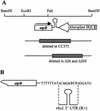
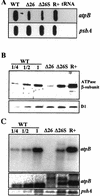
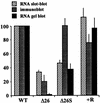
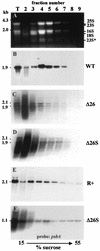

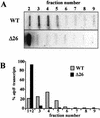
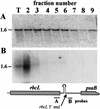
Similar articles
-
3'end maturation of the Chlamydomonas reinhardtii chloroplast atpB mRNA is a two-step process.Mol Cell Biol. 1993 Apr;13(4):2277-85. doi: 10.1128/mcb.13.4.2277-2285.1993. Mol Cell Biol. 1993. PMID: 8455609 Free PMC article.
-
Antisense transcript and RNA processing alterations suppress instability of polyadenylated mRNA in chlamydomonas chloroplasts.Plant Cell. 2004 Nov;16(11):2849-69. doi: 10.1105/tpc.104.026203. Epub 2004 Oct 14. Plant Cell. 2004. PMID: 15486097 Free PMC article.
-
The sequence and structure of the 3'-untranslated regions of chloroplast transcripts are important determinants of mRNA accumulation and stability.Plant Mol Biol. 1998 Jan;36(2):307-14. doi: 10.1023/a:1005943701253. Plant Mol Biol. 1998. PMID: 9484442
-
Altering the 3 UTR endonucleolytic cleavage site of a Chlamydomonas chloroplast mRNA affects 3-end maturation in vitro but not in vivo.Plant Mol Biol. 1999 Jul;40(4):679-86. doi: 10.1023/a:1006252201661. Plant Mol Biol. 1999. PMID: 10480391
-
Post-transcriptional regulation of chloroplast gene expression in Chlamydomonas reinhardtii.Plant Mol Biol. 1996 Oct;32(1-2):327-41. doi: 10.1007/BF00039389. Plant Mol Biol. 1996. PMID: 8980486 Review.
Cited by
-
Differential mRNA stability to endogenous ribonucleases of the coding region and 3' untranslated regions of wheat (Triticum aestivum L.) manganese superoxide dismutase genes.Plant Cell Rep. 2006 Mar;25(2):133-9. doi: 10.1007/s00299-005-0046-9. Epub 2005 Oct 21. Plant Cell Rep. 2006. PMID: 16240120
-
Light activates binding of membrane proteins to chloroplast RNAs in Chlamydomonas reinhardtii.Plant Mol Biol. 2002 Oct;50(3):573-85. doi: 10.1023/a:1020246007858. Plant Mol Biol. 2002. PMID: 12369632
-
Distinct roles for the 5' and 3' untranslated regions in the degradation and accumulation of chloroplast tufA mRNA: identification of an early intermediate in the in vivo degradation pathway.Plant Mol Biol. 2007 Mar;63(5):689-702. doi: 10.1007/s11103-006-9117-8. Epub 2006 Dec 17. Plant Mol Biol. 2007. PMID: 17180456
-
cis- and trans-Acting determinants for translation of psbD mRNA in Chlamydomonas reinhardtii.Mol Cell Biol. 2000 Nov;20(21):8134-42. doi: 10.1128/MCB.20.21.8134-8142.2000. Mol Cell Biol. 2000. PMID: 11027283 Free PMC article.
-
The nucleus-encoded factor MCD4 participates in degradation of nonfunctional 3' UTR sequences generated by cleavage of pre-mRNA in Chlamydomonas chloroplasts.Mol Genet Genomics. 2007 Mar;277(3):329-40. doi: 10.1007/s00438-006-0192-y. Epub 2006 Dec 7. Mol Genet Genomics. 2007. PMID: 17151890
References
-
- Audren H, Bisanz-Seyer C, Briat J F, Mache R. Structure and transcription of the 5S ribosomal RNA gene from spinach chloroplasts. Curr Genet. 1987;12:263–270. - PubMed
-
- Blowers A D, Klein U, Ellmore G S, Bogorad L. Functional in vivo analyses of the 3′ flanking sequences of the Chlamydomonas chloroplast rbcL and psaB genes. Mol Gen Genet. 1993;238:339–349. - PubMed
Publication types
MeSH terms
Substances
LinkOut - more resources
Full Text Sources
